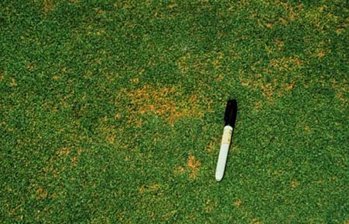Home / Information & advice / Turf & Lawns / Lawn diseases / Anthracnose
Anthracnose occurs in two forms, basal rot and foliar blight, which can develop at different times of year according to weather conditions. It most commonly affects annual meadow grass, but can affect all grasses.
Basal rot symptoms are yellowing leaves, with the youngest leaf brick red in colour and black rot appearing at the base of the leaves.

With foliar blight, symptoms appear as irregular, yellow or brown patches of turf, which turn tan and die. It can be mistaken for drought, however the symptoms worsen with watering and fungal fruiting structures (acervuli) with fine black hair-like setae can usually be seen by using a magnifying glass.
It is caused by the fungus Colletotrichum cereale. It occurs when climatic conditions are suitable and the turf is under stress due to inappropriate or inadequate maintenance.
Basal rot occurs in autumn and winter when conditions are cool and wet. Foliar blight occurs in summer when temperatures are higher. Both are more likely to occur when the turf is stressed due to low fertility (particularly nitrogen), compaction, drought and excessively low mowing heights. Moisture on the leaves and insect/nematode activity can also encourage development of the disease.
Fungicide treatments are available to control Anthracnose, however if the underlying causes are not rectified the disease may return more severely.The disease is best managed by correcting the underlying causes of the disease and following an appropriate maintenance regime will reduce the occurrence and severity.
Further advice on this disease can be obtained from the Sports Turf Research Institute, the UK’s leading independent turf research organisation. Their contact details are STRI, St Ives Estate, Bingley, West Yorkshire, BD16 1AU. Tel: 01274 565131 www.stri.co.uk.